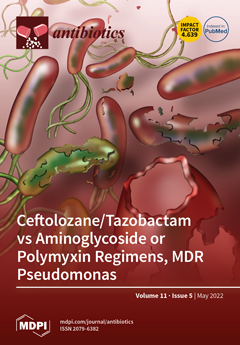Little information is available on the local epidemiology of mobile genetic elements such as plasmids harboring acquired beta-lactamase genes in Western African Ghana. In the present study, we screened for plasmids in three
Escherichia coli and four
Klebsiella pneumoniae isolates expressing extended spectrum
[...] Read more.
Little information is available on the local epidemiology of mobile genetic elements such as plasmids harboring acquired beta-lactamase genes in Western African Ghana. In the present study, we screened for plasmids in three
Escherichia coli and four
Klebsiella pneumoniae isolates expressing extended spectrum beta-lactamases (ESBL) mediated by the
blaCTX-M-15 gene from chronically infected wounds of Ghanaian patients. Bacterial isolates were subjected to combined short-read and long-read sequencing to obtain the sequences of their respective plasmids. In the
blaCTX-M-15-gene-carrying plasmids of the four ESBL-positive
K. pneumoniae isolates, IncFIB/IncFII (
n = 3) and FIA (
n = 1) sequences were detected, while in the
blaCTX-M-15-gene-carrying plasmids of the three ESBL-positive
E. coli isolates, IncFIA/IncFIB (
n = 2) and IncFIB (
n = 1) sequences were found. The three IncFIB/IncFII sequence-containing plasmids were almost identical to a
K. pneumoniae plasmid reported from France. They belonged to the clonal lineages ST17, ST36 and ST39 of
K. pneumoniae, suggesting transversal spread of this obviously evolutionary successful plasmid in Ghana. Other resistance gene-encoding plasmids observed in the assessed Enterobacterales harbored IncFIA/IncR and IncFII sequences. International spread was confirmed by the high genetic similarity to resistance-mediating plasmids published from Asia, Australia, Europe and Northern America, including a
blaCTX-M-15-gene-carrying plasmid isolated from a wild bird in Germany. In conclusion, the study contributed to the scarcely available information on the epidemiology of third-generation cephalosporine resistance-mediating plasmids in Ghana. Furthermore, the global spread of resistance-mediating plasmids provided hints on the evolutionary success of individual resistance-harboring plasmids by transversal spread among
K. pneumoniae lineages in Ghana.
Full article






